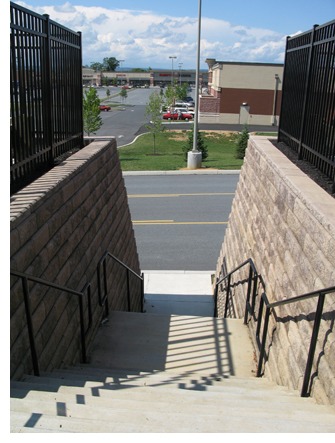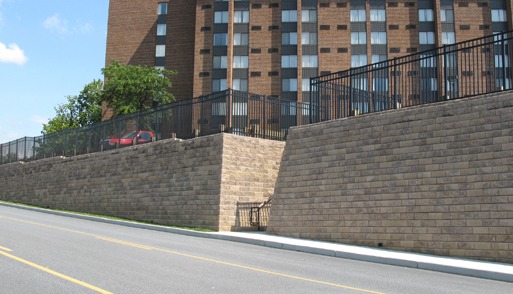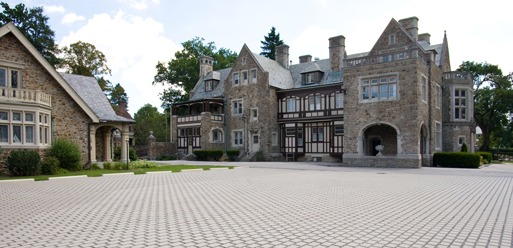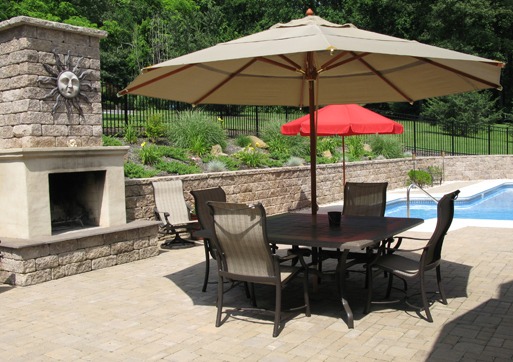Segmental Retaining Wall Units and Pavers Create Usable Space
Words: Jan Boyer
 For many years, hardscape products – segmental retaining wall and pavers – have allowed municipalities, commercial builders, developers and home owners ways to create usable space. With the many different shapes and types available, you can turn an ordinary backyard into an elegant and relaxing space to entertain. A commercial property can allow for structures, parking and traffic control, while municipalities can address stormwater management.
For many years, hardscape products – segmental retaining wall and pavers – have allowed municipalities, commercial builders, developers and home owners ways to create usable space. With the many different shapes and types available, you can turn an ordinary backyard into an elegant and relaxing space to entertain. A commercial property can allow for structures, parking and traffic control, while municipalities can address stormwater management.
The following case studies show how hardscape products can turn ordinary and, many times, challenging spaces into an eco-friendly environment.
High Pointe Commons, Harrisburg, Pa.
This shopping/lodging complex is constructed on a hillside, which included challenges for retaining the earth to create the parking area, numerous walls surrounding the streets constructed to control traffic and water issues, and a parking lot surcharge on the main large wall.
Six separate segmental retaining walls of various heights and lengths were engineered and constructed. The largest wall, supporting the parking lot for the Sheraton Hotel, was designed to address two major factors: handling the storm water drainage for the parking area above and the weight of vehicles being parked in the lot. It also was constructed along the newly designed street that would see a significant amount of traffic and to provide access by stairs to the shops for the residents of the hotel.

This project required the installation of more than 2,000 feet of fencing and handrails. The wall installer worked with the designer and railing installer in advance of the wall construction to coordinate the depth and location of each post footing that needed to be worked into the wall.
The entire project team – excavation, utility installation, material storage, railing installation, and final grading – met in advance to coordinate the scheduling of the various stages and construction of the site.
Spring Creek Hollows Development Bridge ??
A structure was needed to span a creek while supporting a main roadway in the residential development of Spring Creek Hollows, located in south central Pennsylvania. The walls were built in a 100-year flood plain, so the backfill material was all #57 stone wrapped in filter fabric up to one foot above the flood elevation. With a 39-foot, two-inch span, the structure serves as a wildlife underpass, reducing the number of animals crossing the road that could potentially cause a hazard to the animal and to traffic. It was necessary to build in late-fall and winter, under some very cold weather conditions, which played a part in the considerations as well.
The decision was made to use a super span metal plate, because of its capacity to support a large amount of fill in a cost-effective manner. The segmental retaining wall units were used as wing walls, which provided the required aesthetics and addressed the retained earth issues. The total wall area installed was 9,428 square feet, including caps for both walls (both ends of structure). A concrete swale was poured directly behind the cap units to divert the surface water runoff.
Kuhner Funeral Home
When Al Kuhner made the decision to move and expand his funeral home business to a historic home in his town, he was required to not only transform the home, but also create a parking lot. This 10,000-square-foot parking lot was to complement the existing early-20th century architecture and comply with 21st century zoning restrictions on impervious surfaces.

Permeable pavers were chosen for this project as they are a good match to the natural grey of the stone in the home and, most importantly, created a durable surface that allows water to infiltrate to the subsoil making it eco-friendly. The aesthetics of the project were outstanding as well for the owner and the municipality.
Residential project combines segmental retaining wall and pavers
After adding a new addition to his rural home, the homeowner designed and built a large outdoor living area with an in-ground pool; a complex, 360-degree perimeter drainage and underground vault system to access septic tanks; and a custom-built fireplace. He back-sloped the area above and behind the retaining walls, and added soft landscaping for depth and color.

In the patio area, tumbled pavers complemented the walls and covered access to the underground septic tanks. The custom-designed fireplace included hand-laid firebrick and a mix of several different materials.
No matter what the size of your project, plan ahead and include all key municipal, design and construction personnel to ensure a quality structure with a lifetime of service.
Return to Table of Contents